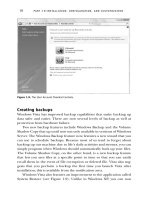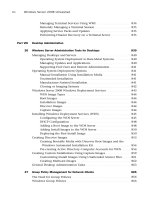The Complete Guide to Windows Server 2008 P2
Bạn đang xem bản rút gọn của tài liệu. Xem và tải ngay bản đầy đủ của tài liệu tại đây (199.61 KB, 10 trang )
The new Web edition was a much-scaled-back version of the Windows
Server product and aimed at combating the trend of using free Linux-
based services for hosting web sites.
You might run Windows 2000 servers today, so the following list covers
the new features of Windows 2003. These features carried into Windows
Server 2008, so they are still reasons to migrate to the latest server OS.
■
The Microsoft .NET Framework became a core part of the OS.
■
New Active Directory features provided prune and graft functional-
ity, allowing you to move and rename domains within an Active
Directory forest.
■
Domain controllers were added via a system state backup of anoth-
er domain controller, instead of copying all domain information over
the network.
■
Internet Information Services (IIS) 6.0 offered improved security
with its default state of lockdown and new management features.
IIS 6.0 also featured improved reliability and allowed consolidation
where appropriate.
■
Updated Terminal Services allowed access to and control of the
server console via the
/console
switch of the mstsc application.
■
Virtual Disk Service (VDS) provided single interface for disk man-
agement.
■
Volume Shadow Copy Service (VSS) allowed point-in-time copies of
information known as shadow copies and provided client side-access
to previous “versions” of a share, enabling clients to restore deleted
information without administrators performing time-consuming
tape restorations.
■
Windows Server 2003 included the visual style of Windows XP but
disabled it by default. It is accessible if the Themes service is
enabled and the Windows XP theme is selected for the display prop-
erties.
An important term to mention here is service pack. Feature packs
deliver new features to the OS; however, as with every piece of software,
errors creep into the released product. These errors require fixing and
Microsoft often releases repairs as hot fixes. After some interval, Microsoft
combines the fixes into a service pack, which might also contain customer-
requested updates. Microsoft makes each service pack available from its
web site at no charge. The user installs the service pack onto an installed
OS (or directly onto installation media in later versions of Windows). This
brings the OS up-to-date with the latest set of fixes and sometimes adds
10
Chapter 1 Windows 101: Its Origins, Present, and the
Services It Provides
new functionality, although not features or changes that cause compatibil-
ity issues. In Service Pack 1 for Windows 2003, Microsoft added the
Security Configuration Wizard, which was a core part of helping to lock
down server installations. Service packs are cumulative, so Service Pack 2
contains everything in Service Pack 1. If you install a new computer, only
install the latest service pack—you don’t need to install all the previous
service packs. In the past, if you added new OS components to an installed
OS (for example, enabling domain name service [DNS] on a server), you
had to reapply the service packs. This is no longer required because the
content of the service pack is stored locally on the server to ensure that the
newest code is always used.
Microsoft continued to add new features to Windows 2003 via down-
loadable feature packs. Major new features were not made available in
service packs due to past complications, so feature packs were a great com-
promise. Users who didn’t want to wait for the next major release could get
features as Microsoft released them. Other users were free from installing
features they did not want and that could introduce complexity or poten-
tial security considerations. Feature packs available for download include
the following:
■
Active Directory Application Mode (ADAM). Active Directory
“lite,” enabling multiple directories to exist on a single Windows
2003 or XP machine without the full infrastructure of DNS and
other components normally required for a domain. ADAM stores
data related to an application that does not require the availability
associated with data stored in an AD-based domain.
■
Group Policy Management Console (GPMC). Enables policy
backup and restoration of policies, task scripting, better manage-
ment, and HTML reports.
■
Identity Integration Feature Pack (IIFP). Allows replication
among AD, ADAM, and Exchange directory service (2000 and
2003). This is useful in multiforest situations to sync the Global
Address List (GAL). IIFP is MS Identity Integration Server (MIIS)
lite!
■
ISCSI support. Enables IP-based storage area network (SAN) con-
nectivity via the Internet Small Computer System Interface (iSCSI).
■
Windows Software Update Services (SUS). Deploys critical
updates throughout a company in a manager manner.
■
Windows Rights Management Services (RMS). Provides rights
management protection with RMS-enabled applications to
11
1.W
INDOWS
101: I
TS
O
RIGINS
, P
RESENT
,
ANDTHE
S
ERVICES
I
T
P
ROVIDES
Origin of the Windows Operating System
safeguard digital info when online or offline. Controls, for example,
what a person can do when received (cut/paste, forward, and so on).
■
Windows Services for NetWare/UNIX. Offers greater integra-
tion and migration capabilities than previous versions.
■
Windows SharePoint Services (WSS) update. Improved
SharePoint capabilities and security.
■
Windows Automated Installation Kit. Contains tools and infor-
mation for the deployment of Windows Vista from a Windows
2003–based infrastructure including Windows Deployment
Services (WDS), which replaces Remote Installation Service (RIS)
and forms a core part of Windows Server 2008.
R2 on Disk 2, R2D2
At the end of 2005, Microsoft started a new tradition, releasing Windows
2003 R2 (short for Release 2). There are two important factors for this R2
release:
■
Windows 2003 R2 is Windows 2003 with Service Pack 1 built in.
■
It has no new kernel changes or modifications to the core OS. The
R2 relates to a second supplied CD that contains new features orig-
inally slated for and built in to the Windows Server 2008 OS.
R2 releases will be seen in other products in the Microsoft line.
Windows 2003 R2 comprises two CDs: the first CD contains Windows
2003 with SP1, and the second contains the new content. After installation
of the first disc, the installer prompts the user to insert the second CD. If
a server is already running Windows 2003 SP1, only the second CD has to
be inserted.
The only actual change made to the core OS is that a new version of
the MMC (3.0) is installed before the second CD is executed and new fea-
tures are added. The new version of the MMC allows for new functionali-
ty provided by the updated management console, which some of the R2
component snap-ins require. Add/Remove Programs is updated to allow
for the installation of the new R2 components, and the Manage/Configure
Your Server Wizard introduces a new SharePoint role and updates the File
and Printer Server roles. View the R2 as a collection of useful feature
packs, but installing them does not affect the core OS. There are no sepa-
rate service packs for Windows 2003 and Windows 2003 R2 because they
are the same core OS. You don’t need to retest your software and recerti-
fy applications any more than if you installed a feature pack on a server.
12
Chapter 1 Windows 101: Its Origins, Present, and the
Services It Provides
The only testing to perform is to ensure that any MMC snap-ins run with
MMC 3.0.
You run a mixture of Windows 2003 and Windows 2003 R2 systems in
your environment. Upgrade to R2 only those servers that require some of
the new features R2 contains—don’t upgrade every server. For an existing
Windows 2003 Service Pack 1 system, only use the second CD of R2,
which “upgrades” it to R2. (It updates the MMC and modifies
Add/Remove Programs to let you add the new R2 features.)
R2 contains a mixture of brand new features and features previously
available as feature pack downloads (for example, ADAM and SharePoint
services). The new features are summarized as follows:
■
The new Distributed File System Replication (DFSR) engine facil-
itates simplified branch office management by performing delta
replication of files between locations. Delta replication means that
only the changes to a file replicate instead of replicating the whole
file. This saves bandwidth between locations. DFSR is also more
self-fixing and tolerant than FRS, making it far less likely to “break”
and require administrative effort to restart replication. Although the
engine’s name is DFSR, use it separately from Distributed File
System (DFS) name spaces to replication information in many dif-
ferent scenarios. A new Print Management Console allows a cen-
tralized view and management of printers in distributed environ-
ments, allowing centralized driver upgrades, printer discovery on
remote subnets, form configuration, and notification options if a
printer becomes unavailable, which includes executing a script or
sending an e-mail.
■
Active Directory Federated Services (AD FS) extends the visibility
of a trusted organization’s directory service to allow its users access to
Web-based applications in another organization. For detailed infor-
mation, see www.windowsitpro.com/Windows/Article/ArticleID/
48252/48252.html.
■
WSS SP2 is .NET 2.0–compatible and certified to run on 64-bit. (It
is 32-bit code but is certified to run in Windows on the Windows
subsystem that 64-bit OSs use to run 32-bit code.) SharePoint
Services SP2 supports Kerberos authentication and fully integrates
with Windows (now shows as a Server role and in Add/Remove
Windows Components).
Add all R2 components as entries in the Windows Components
dialog.
13
1.W
INDOWS
101: I
TS
O
RIGINS
, P
RESENT
,
ANDTHE
S
ERVICES
I
T
P
ROVIDES
Origin of the Windows Operating System
■
Improved UNIX integration and management capabilities, includ-
ing password synchronization between UNIX and Windows. Mixed
mode support enables a mixture of Windows and Interix libraries.
■
.NET 2.0 is included as well as the Common Log File System
(CLFS), a callable driver that provides a robust sequential logging
environment for use by applications as required.
■
Improved hardware management. A Simple SAN MMC snap-in
enables full life-cycle control of most small-to-medium SAN envi-
ronments via the Virtual Disk Service (VDS), which includes cre-
ation and assigning of logical unit numbers (LUNs), configuring
connections, creating partitions, and so on. A WS-Management
(Web Services) implementation is included—for supported hard-
ware that means remote access to servers, even in a crash or pre-
boot scenario. Interaction with the Baseboard Management
Controller (BMC) allows Windows-based reading and writing of
hardware configuration, reading of the hardware’s equivalent of the
event log (System Event Log [SEL]) via the Windows Event Viewer,
and triggering actions using standard Windows mechanisms, if
required.
■
A new Quota Management component comprising three technolo-
gies. One component is a new quota system based on the physical
space (rather than logical size) used on a disk. If users compress
files, they store more data, which was not the case in a logical size
quota. The quotas can be set on a folder or disk level, so you can
configure a specific folder not to exceed 500MB. A file-screening
component allows for real-time file type checking. If a type of file
tries to write to a folder that has a rule stopping that type, an I/O
error generates and the file write stops. One useful scenario for this
technology is for blocking video/audio files to company file shares.
For both quotas and file screening, comprehensive actions occur
when a user attempts to breach policy. Actions could include e-mail-
ing the offender, e-mailing an administrator/manager, and perform-
ing an action. Storage reports are the third technology, providing
detailed reports of file system status in a variety of formats.
Why put out an R2 release? Microsoft already set a precedent with fea-
ture packs that added functionality to the Windows 2003 product as free
downloads from the Microsoft site, so why not just have the R2 features
provided as downloads as separate feature packs? There are two trains of
thought on this issue. It’s important to realize that Windows 2003 R2 is a
separate product; there is no upgrade version or free update. You have to
14
Chapter 1 Windows 101: Its Origins, Present, and the
Services It Provides









